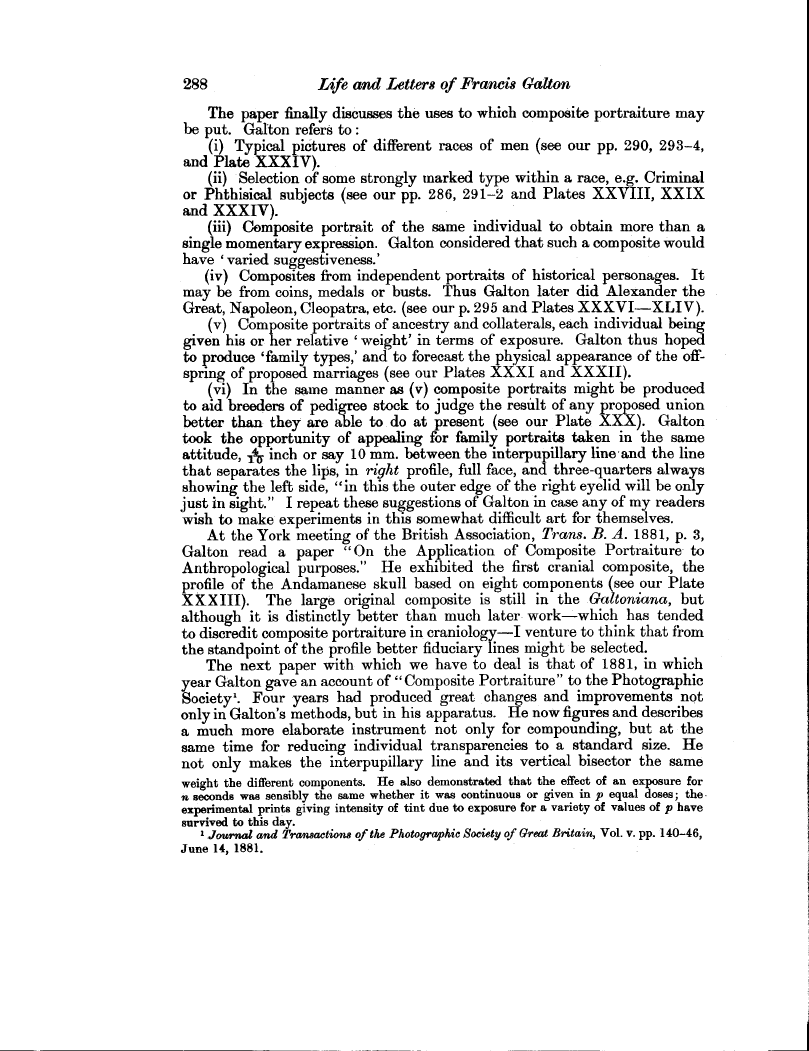288 Life and Letters of Francis Galton
The paper finally discusses the uses to which composite portraiture may be put. Galton refers to
(i) Typical pictures of different races of men (see our pp. 290, 293-4, and Plate XXXIV).
(ii) Selection of some strongly marked type within a race, e.g. Criminal or Phthisical subjects (see our pp. 286, 291-2 and Plates XXVIII, XXIX and XXXIV).
(iii) Composite portrait of the same individual to obtain more than a single momentary expression. Galton considered that such a composite would have `varied suggestiveness.'
(iv) Composites from independent portraits of historical personages. It may be from coins, medals or busts. Thus Galton later did Alexander the Great, Napoleon, Cleopatra, etc. (see our p. 295 and Plates XXXVI-XLIV).
(v) Composite portraits of ancestry and collaterals, each individual being given his or her relative `weight' in terms of exposure. Galton thus hoped to produce `family types,' and to forecast the physical appearance of the offspring of proposed marriages (see our Plates XXXI and XXXII).
j(vi) In the same manner as (v) composite portraits might be produced to aid breeders of pedigree stock to judge the result of any proposed union better than they are able to do at present (see our Plate XXX). Galton took the opportunity of appealing for family portraits taken in the same attitude, A' inch or say 10 mm. between the interpupillary line-and the line that separates the lips, in right profile, full face, and three-quarters always showing the left side, "in this the outer edge of the right eyelid will be only ust in sight." I repeat these suggestions of Galton in case any of my readers wish to make experiments in this somewhat difficult art for themselves. At the York meeting of the British Association, Trans. B. A. 1881, p. 3, Galton read a paper "On the Application of Composite Portraiture- to Anthropological purposes." He exhibited the first cranial composite, the profile of the Andamanese skull based on eight components (see our Plate XXXIII). The large original composite is still in the Galtoniana, but although it is distinctly better than much later work-which has tended to discredit composite portraiture in craniology-I venture to think that from the standpoint of the profile better fiduciary lines might be selected.
The next paper with which we have to deal is that of 1881, in which year Galton gave an account of "Composite Portraiture" to the Photographic Society'. Four years had produced great changes and improvements not only in Galton's methods, but in his apparatus. He now figures and describes a much more elaborate instrument not only for compounding, but at the same time for reducing individual transparencies to a standard size. He not only makes the interpupillary line and its vertical bisector the same weight the different components. He also demonstrated that the effect of an exposure for n seconds was sensibly the same whether it was continuous or given in p equal doses; the experimental prints giving intensity of tint due to exposure for a variety of values of p have
survived to this day.
I .Journal and Transactions of the Photographic Society of Great Britain, Vol. v. pp. 140-46, June 14, 1881.

